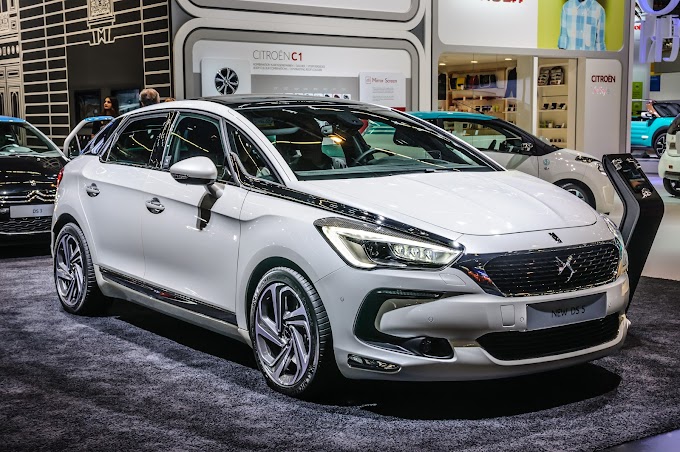How to Maximize Fuel Efficiency: 10 Tips for Getting the Most Out of Your Tank
%20(1).png)
When it comes to maximizing fuel efficiency,
there are several strategies that drivers can employ to get the most out of
every tank of gas. By making simple adjustments to driving habits and vehicle
maintenance, individuals can save money, reduce their carbon footprint, and
increase the longevity of their vehicles. In this article, we will explore ten
practical tips to help you achieve optimal fuel efficiency. From driving
techniques to vehicle maintenance practices, each tip is designed to help you
squeeze out the most miles per gallon from your vehicle. By implementing these
suggestions, you can become a more eco-friendly and cost-conscious driver while
also enhancing the overall performance of your car. Let's delve into these
strategies to ensure you are getting the best possible fuel efficiency out of
your vehicle.
Proper Maintenance
Regular maintenance is crucial for maintaining optimal fuel efficiency in a vehicle.- 1. Keep Up with Routine Service
- Regular
oil changes, air filter replacements, and spark plug checks can
significantly improve fuel efficiency.
- Ensure
the tires are properly inflated to the recommended pressure levels to
reduce drag and improve gas mileage.
- 2. Follow the Manufacturer's Maintenance
Schedule
- Adhering
to the vehicle manufacturer's recommended maintenance schedule can help
catch any issues early on and prevent more significant problems that
could impact fuel efficiency.
- 3. Check for Engine Issues
- Addressing
engine problems promptly, such as a malfunctioning oxygen sensor or a
faulty fuel injector, can aid in maximizing fuel efficiency.
- 4. Maintain a Smooth Driving Style
- Aggressive
driving, rapid acceleration, and sudden stops can increase fuel
consumption. Encouraging a more relaxed driving style can help save fuel.
- 5. Use the Right Motor Oil
- Using
the manufacturer-recommended grade of motor oil can decrease friction
within the engine and improve fuel efficiency.
- 6. Get Regular Tune-Ups
- Regular
tune-ups can help ensure the engine is running efficiently, thereby
maximizing fuel economy. Proper maintenance practices can go a long way
in enhancing a vehicle's fuel efficiency and performance. Remember that a
well-maintained vehicle not only saves money on gas but also contributes
to a cleaner environment.
Driving Habits
- Avoid
Aggressive Driving: Rapid acceleration and braking can lower fuel efficiency by
up to 33% on the highway and 5% in the city.
- Maintain
a Consistent Speed: Driving at a steady pace can improve fuel efficiency. Use
cruise control on highways to help maintain a constant speed.
- Avoid
Excessive Idling: Idling wastes fuel. Turn off your engine if you anticipate a
wait of more than a minute.
- Anticipate
Traffic Flow: Look
ahead to anticipate stops and starts, allowing you to ease off the gas
earlier instead of braking suddenly.
- Use
Lower Octane Gas: Check your owner’s manual to see if your car can run on
regular unleaded gasoline, which is cheaper than premium.
- Remove
Excess Weight: Extra
weight in your car means more work for the engine and decreased fuel
efficiency. Remove unnecessary items to lighten the load.
- Keep
Tires Inflated: Underinflated
tires can lower gas mileage. Check your tire pressure regularly to ensure
they are properly inflated.
- Use
Air Conditioning Wisely: AC can decrease fuel efficiency, especially at lower speeds. Use
the flow-through ventilation when possible.
- Avoid Roof Racks: Roof racks create
drag and reduce fuel efficiency. Remove them when not in use to improve
gas mileage.
- Plan Efficient Routes: Avoid traffic
congestion and excessive idling by planning your route in advance. Opt for
routes with fewer stops and smoother traffic flow.
Fuel-Efficient Vehicles
When it comes to maximizing fuel
efficiency, choosing a fuel-efficient vehicle is a crucial first step. Here are
some tips to consider when selecting a vehicle that will help you get the most
out of your tank:
- Hybrid or Electric Vehicles: Consider
investing in a hybrid or electric vehicle, as they are known for their
excellent fuel efficiency and eco-friendly features.
- Smaller Engine Size: Vehicles with smaller
engines tend to be more fuel-efficient, so opt for a car with an engine
size that meets your needs without being excessive.
- Aerodynamic Design: Look for vehicles with
aerodynamic designs, as they can help reduce drag and improve fuel
efficiency on the road.
- Lightweight Construction: Vehicles made with
lightweight materials consume less fuel, so prioritize cars that
incorporate such construction.
- Fuel-Efficient Tires: Choose tires
specifically designed to improve fuel efficiency, enhancing your vehicle's
overall performance.
- Regular Maintenance: Ensure your vehicle
receives regular maintenance check-ups to keep it running efficiently and
maintain its fuel efficiency over time.
- Drive Smart: Practice eco-driving techniques
such as smooth acceleration, maintaining a steady speed, and avoiding
sudden stops to improve your vehicle's fuel efficiency.
- Proper Tire Inflation: Keep your tires
properly inflated, as underinflated tires can decrease fuel efficiency.
- Plan Efficient Routes: When possible, plan
your routes to avoid traffic congestion and minimize idle time, which can
help save fuel.
By incorporating these tips and
selecting a fuel-efficient vehicle, you can make significant strides in
maximizing your fuel efficiency and getting the most out of every tank.
Maximizing Aerodynamics
- Ensuring your vehicle is streamlined and
aerodynamic can significantly improve fuel efficiency. One way to achieve
this is by removing any unnecessary items from the roof or exterior of the
car. This reduces drag and improves aerodynamics, ultimately saving fuel.
- Keep windows closed while driving at higher speeds
to reduce air resistance and improve aerodynamics. Open windows can
disrupt the airflow around the vehicle, causing it to work harder and
consume more fuel.
- Use the air conditioning thoughtfully. At lower speeds,
it's more fuel-efficient to roll down the windows instead of using the air
conditioning, but at higher speeds, using the A/C may be more
aerodynamically efficient as open windows can create drag.
- Consider investing in aerodynamic upgrades such as
a spoiler or air dam to optimize airflow around the vehicle, reducing drag
and improving fuel efficiency.
- Maintain an appropriate distance between vehicles
while driving. Tailgating not only reduces reaction time but also
increases air resistance, reducing fuel efficiency. Keeping a safe
distance allows for smoother airflow around both vehicles.
- Avoid carrying items on roof racks when not
necessary. Roof racks create additional drag, making the vehicle less
aerodynamic and increasing fuel consumption.
- Close sunroofs when driving at higher speeds. An
open sunroof can significantly impact the aerodynamics of a vehicle,
increasing drag and fuel consumption.
- Keep your vehicle clean and free of dirt or debris.
A dirty car disrupts the airflow around the vehicle, increasing drag and
reducing fuel efficiency.
- Choose a car with a streamlined design if possible.
Some vehicles are inherently more aerodynamic than others, so consider
this factor when purchasing a new car to maximize fuel efficiency.
- Regularly maintain your vehicle, including keeping
tires properly inflated and ensuring wheel alignment is correct. Proper
maintenance helps reduce rolling resistance and ensures the vehicle
operates at peak aerodynamic efficiency.
Smart Route Planning
- Utilize GPS or map applications to find the most
direct and fuel-efficient route to your destination.
- Avoid high-traffic areas and look for alternative
routes to reduce time spent idling in traffic.
- Plan your trips efficiently by combining multiple
errands into one outing to minimize overall mileage.
- Consider using apps that offer real-time traffic
updates to help you avoid congestion and potential delays.
- Choose routes with smoother roads to reduce the
need for sudden braking and acceleration, which can lower fuel efficiency.
- Take advantage of eco-routing features in some
navigation apps that suggest routes based on fuel efficiency rather than
just distance or time.
- Prioritize routes with lower speed limits as
driving at slower speeds can significantly improve fuel economy.
- Avoid routes with excessive hills or steep
inclines, as these can put additional strain on your vehicle and decrease
fuel efficiency.
- Keep an eye out for construction zones or road
closures and plan alternate routes ahead of time to avoid unnecessary fuel
consumption.
By incorporating smart route
planning into your driving habits, you can optimize fuel efficiency and make
the most of every tank of gas.
Optimizing Tire Pressure
Maintaining the correct tire
pressure is crucial for maximizing fuel efficiency. Here are some tips for
optimizing tire pressure:
- Regularly Check Tire Pressure: Ensure to
check your tire pressure regularly, at least once a month, using a tire
pressure gauge. This small step can significantly impact fuel efficiency.
- Follow the Manufacturer's Guidelines: Refer
to your vehicle's manual or the sticker located on the driver's side door
jamb for the recommended tire pressure. It's essential to adhere to these
guidelines for optimal performance.
- Avoid Underinflated Tires: Underinflated
tires increase rolling resistance, causing the engine to work harder and
consume more fuel. Inflate tires to the recommended pressure to improve
fuel efficiency.
- Consider Overinflation: While underinflation
is harmful, overinflated tires can also impact fuel efficiency and tire wear.
Stick to the recommended pressure for the best balance.
- Check Tire Pressure When Cold: Tire pressure
changes with temperature, so it's best to check them when they are cold
for the most accurate readings.
- Monitor Tire Wear: Inspect your tires
regularly for signs of wear or damage. Worn-out tires can affect fuel
efficiency and safety.
- Invest in a Tire Pressure Monitoring System
(TPMS): Consider installing a TPMS in your vehicle to receive
real-time updates on tire pressure and optimize fuel efficiency.
- Rotate Tires Regularly: Rotating tires
regularly helps ensure even wear, extending their lifespan and maintaining
fuel efficiency.
By following these tire pressure
optimization tips, drivers can improve fuel efficiency, reduce fuel
consumption, and ultimately save money in the long run.
Efficient Use of Air Conditioning
- Use air conditioning selectively: Turning on the
air conditioning only when necessary can help save fuel. The system puts
added strain on the engine, leading to increased fuel consumption.
- Park in the shade: Parking in shaded areas can help
keep your car cooler, reducing the need for prolonged use of the air
conditioning when you start driving again.
- Use the recirculation mode: When the air
conditioning is on, using the recirculation mode can help cool the car
faster since the system is not pulling in hot air from outside.
- Service the air conditioning system: Regular
maintenance of the air conditioning system, such as checking for leaks and
ensuring proper refrigerant levels, can help it run more efficiently.
- Don't set the temperature too low: Setting the air
conditioning to a moderate temperature can help save fuel compared to
blasting it on the coldest setting.
- Roll down the windows at lower speeds: At lower
speeds, consider rolling down the windows instead of using the air
conditioning to cool the car, as this can be more fuel-efficient.
By implementing these strategies,
drivers can enjoy a comfortable cabin temperature while also maximizing fuel
efficiency during their journeys.
Minimizing Weight
When it comes to maximizing fuel
efficiency, minimizing weight is crucial. Excess weight in your vehicle can
lead to increased fuel consumption. Here are some tips for reducing the weight
of your vehicle:
- Remove unnecessary items: Regularly
check your car for any items that you don't need to have in it. Extra
weight, even small items, can add up and affect fuel efficiency.
- Clean out the trunk: Avoid using your
trunk as a storage space for heavy items that you don't need for your
journey. Clearing out your trunk can help lighten the load on your
vehicle.
- Use lightweight materials: If you're
considering modifications or additions to your vehicle, opt for
lightweight materials whenever possible. This can help reduce the overall
weight of your vehicle.
- Consider downsizing: If you regularly
drive a larger vehicle but don't require the extra space, consider
downsizing to a smaller, more fuel-efficient vehicle. Less weight means
better fuel efficiency.
- Check tire pressure: Properly inflating
your tires not only improves safety but also helps with fuel efficiency.
Underinflated tires can increase fuel consumption due to higher rolling
resistance.
A lighter vehicle puts less
strain on the engine, requiring less fuel to operate. By taking steps to
minimize the weight of your vehicle, you can improve fuel efficiency and save
money on gas in the long run.
Utilizing Technology
- Utilize cruise control: Cruise control
allows drivers to maintain a consistent speed, which can improve fuel
efficiency by preventing excessive acceleration and deceleration.
- Use GPS navigation: GPS navigation can help
drivers find the most efficient routes to their destinations, avoiding
traffic jams and reducing fuel consumption.
- Invest in a fuel-efficient vehicle: Modern
vehicles come equipped with technology designed to improve fuel efficiency,
such as hybrid engines, automatic start-stop systems, and aerodynamic
designs. Investing in a fuel-efficient vehicle can lead to significant
savings on fuel costs.
- Monitor tire pressure with a TPMS: A Tire
Pressure Monitoring System (TPMS) can alert drivers when their tire
pressure is low, helping to maintain optimal tire pressure levels for
improved fuel efficiency.
- Consider using a fuel tracker app: Fuel
tracker apps can help drivers keep track of their fuel consumption,
identify patterns, and adjust their driving habits to maximize fuel
efficiency.
- Utilize eco-driving apps: Eco-driving apps
provide real-time feedback on driving habits such as acceleration,
braking, and speed, helping drivers adjust their behavior to conserve
fuel.
- Explore electric or hybrid options: Electric
and hybrid vehicles offer excellent fuel efficiency and reduced emissions,
making them a sustainable choice for environmentally conscious drivers.
- Stay updated on maintenance schedules: Regular
maintenance, including oil changes, air filter replacements, and engine
tune-ups, can help keep a vehicle running efficiently and maximize fuel
economy.
By incorporating technology into
their driving habits and vehicle choices, drivers can make significant strides
towards maximizing fuel efficiency and reducing their carbon footprint.
Final
- Consideration of driving habits and vehicle
maintenance are crucial for maximizing fuel efficiency.
- Implementing simple tips like maintaining steady
speeds, proper tire inflation, and regular maintenance can make a
significant impact.
- Planning routes in advance, avoiding excessive
idling, and reducing excess weight in the vehicle are effective strategies.
- Being mindful of using air conditioning at lower
speeds and exploring alternative transportation methods can also help save
fuel.
- Utilizing cruise control on highways and driving at
moderate speeds are additional ways to enhance fuel efficiency.
- Investing in a more fuel-efficient vehicle or
considering carpooling and public transportation can also contribute to
reducing fuel consumption.
- By combining these tips and making conscious
decisions, individuals can optimize their fuel efficiency and reduce their
environmental impact.

.png)

.png)
.png)
.png)
.png)
